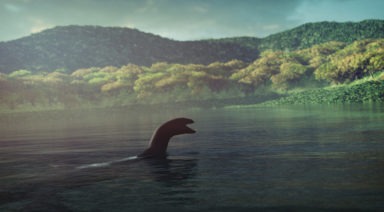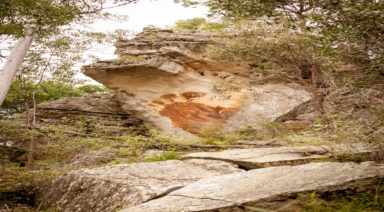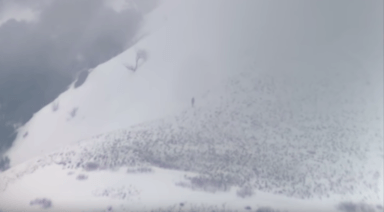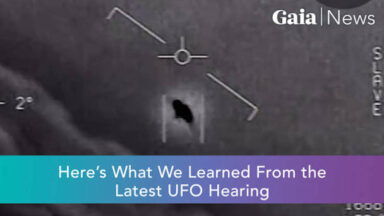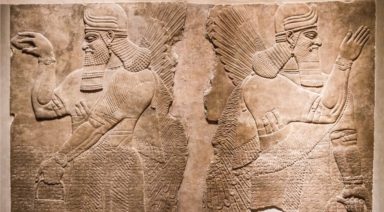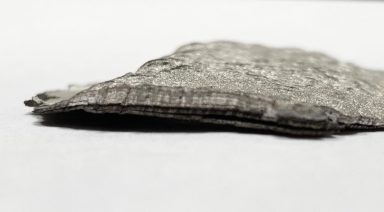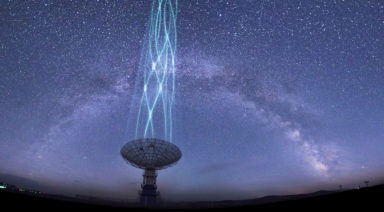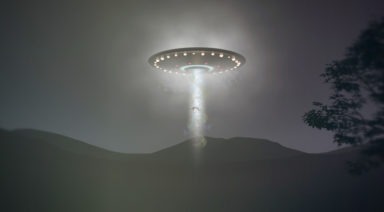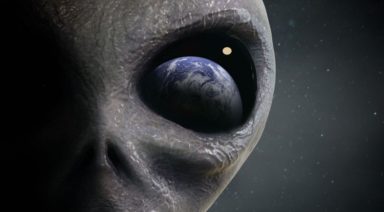What is Cryptozoology?

Myths of legendary creatures — beasts of enormous proportion with strange combinations of horns and hoofs with magical capacities to disappear or shape-shift on a whim, can be found in almost every culture. The Book of Imaginary Beings, by Jorge Luis Borges, is an artistic catalog of these mythical creatures. The author draws on traditions from around the world to create a bestiary of beings we have imagined into creation. He describes 116 unique characters, including “dragons… centaurs… Lewis Carroll’s Cheshire Cat and the Morlocks of H.G. Wells’ The Time Machine.”
According to a paper published by Palomar College, “About 1.8 million (species) have been given scientific names. Thousands more are added to the list every year. Over the last half century, scientific estimates of the total number of living species have ranged from three to 100 million. The most recent methodical survey indicates that it is likely to be close to nine million, with 6.5 million of them living on the land and 2.2 million in the oceans.”
Compare these numbers (1.8 million actual; nine million potential species) to the paltry 116 imaginary beings offered by Borges, and we can understand why he asserts that “the zoology attributable to dreams is in fact considerably more modest than that attributable to God.”
Given the expanses of yet unexplored jungle and deep ocean territory on our very own planet, even 9 million total species may be a conservative guess. It is extraordinarily exciting to imagine all the fantastic creatures that may in fact be real and simply awaiting (or perhaps actively avoiding) our discovery.
WHAT IS CRYPTOZOOLOGY?
According to Loren Coleman, the director of the International Cryptozoology Museum in Portland, Maine, “cryptozoology… literally means the study of hidden or unknown animals.”
If only 1.8 million of the presumed nine million species on the planet have been identified, that means there are something like 7.2 million unique animals yet to be discovered. Thus, cryptozoology, often derided as pseudo-science, is in fact a necessary and cutting-edge pursuit.
Coleman offers a more thorough and specific definition, asserting that, “cryptozoology is the study of hidden animals (whether large or small) to date not formally recognized by what is often termed Western science or formal zoology but supported in some way by testimony (in its broadest definition) from a human being and evidence of their presence.”
Most famously, cryptozoology is associated with creatures like Bigfoot (Sasquatch), the Yeti (Abominable Snowman) and the Loch Ness monster (Nessie). While direct evidence of these beings is fleeting at best, the fact of their existence is deeply rooted in our collective consciousness. Local legends, solitary eyewitness accounts, mysterious footprints and fur samples all spur the ongoing search for verification.
WHAT ARE CRYPTIDS?
The elusive animals which are the subjects of cryptozoological research are collectively known as cryptids. Cryptids are a bit difficult to discuss because they are by definition largely unknown. If we become too familiar with the identifying characteristics of any given animal, it ceases to be a cryptid.
Given the profound rarity of cryptid sightings, Coleman tells us that the primary sources for information about cryptids comes from “the input of local, native, explorer, and traveler traditions, sightings, tales, legends and folklore of the as-yet unverified animals.”
For this reason, according to Bernard Heuvelmans, cryptozoological research is “conducted more extensively in libraries, newspaper morgues, regional archives, museums, art galleries, laboratories, and zoological parks rather than in the field.”
The classic image of Bigfoot captured on film.
CRYPTOZOOLOGY CREATURES PROVEN REAL
Paradoxically, this is an actual science based on rumor and hearsay, a legitimate discipline dedicated to proving the stuff of local legends and cultural myths to be true. This might be easy to dismiss if it weren’t for the large and growing catalog of cryptozoology creatures proven real.
THE PONGO
One of the most famous examples was known as the Pongo. In African folklore, according to The Cryptid Zoo, “the Pongo was a wild man of the jungle. Looking like a cross between a human and a monkey, he was a violent creature with magical powers” and a penchant for shape-shifting and an appetite for human flesh.
In 1847, the world was shocked by the announcement that the Pongo truly exists. Of course we now know that gorillas are vegetarians, gentle giants who neither capture, consume nor reproduce with humans. Nonetheless, their long-standing cultural association with such terrifying qualities survives in their very name, as “gorilla” is derived from the Arabic word for “ghoul.”
THE COELACANTH
Another success story concerns the Coelacanth (SEEL-uh-kanth) — a prehistoric fish thought to be extinct for 65 million years. That is, until 1938, when this strange “living fossil fish” showed up in a South African fish market.
(http://www.newanimal.org/coelacanth.htm) The Cryptid Zoo tells us that “After being identified as a coelacanth and stuffed as a taxidermic specimen to preserve it, doubts were expressed about whether it was genuine. Scientists brought out all the arguments that they typically use to explain away cryptids, including that it was a misidentified normal animal… it was accused of being a common grouper, even though the remains did not resemble that fish. A second coelacanth was not captured until 1952.”
Since then, many live coelacanths have been captured and two subspecies have been identified, with the potential for more to come. Thus, despite deeply-seeded initial skepticism, the persistent existence of this prehistoric fish is now indisputable scientific fact.
According to the International Society of Cryptozoology, the coelacanth is considered a cryptid even though the fossil record proved its previous existence because “what makes an animal of interest to cryptology is that it is unexpected.”
The coelacanth is also significant in that it’s unique anatomical structures may demonstrate one link in the evolutionary chain that led animals out of the sea and onto land.
These are but two of the many stories out there of animals whose contemporary existence was purely speculative but later, through diligence and luck, was proven to be as real as the common squirrel.
For more such examples, The Cryptid Zoo has an extensive archive of information about various cryptids from around the world.
Want to be a Cryptozoologist?
A skilled cryptozoologist has mastered a wide range of disciplines, including but by no means limited to physical anthropology, mythology, linguistics, archaeology and history. Given the range and depth of research required to be a successful cryptozoologist, it’s no surprise that there are several Ph.D programs focused on the science.
One example is the Institute of Metaphysical Humanistic Science (IMHS), an online program where “students will learn about… taxonomy and classification, research techniques, conducting field investigations, equipment, and working with other researchers. Evidence analysis is also covered, equipping students to analyze photos, videos, and other items that might assist in scientifically describing a reported animal. As an alternative, students may choose to specialize in “Hominology,” a branch of Cryptozoology focused on the study of primates or hominids such as Bigfoot, as opposed to all types of cryptids.”
However, an online degree is only worth the energy you personally apply to your studies. If you’ve got a true passion for cryptozoology, you must be first and foremost self-taught and self-motivated.
A great place to start your research is by studying myths, legends and folklore from your geographical area of interest.
Are you planning a trip to a place with excellent cryptozoological potentials? Or are you curious about what might be found lurking in the woods just beyond your backyard?
START YOUR OWN RESEARCH
Either way, Theresa Bane’s “Encyclopedia of Beasts and Monsters in Myth, Legend and Folklore” is a valuable resource. As the author writes in the preface, she believes this volume “to be unique in its completeness and in the breadth of its sources. I was determined to include every possible creature, leaving no culture, religion or time period untouched.”
For further inspiration, turn to George Noory’s Beyond Belief episode titled “The CryptoHunter with John Rhodes,” wherein they explore Rhodes obsession with seeking out the 85% of unknown creatures that currently share our planet.
For even more esoteric theories and applications, I recommend Max Igan’s ebook “Earth’s Forbidden History” wherein he discusses “Out-of-Place Parts” (OOPARTS), like a swiss watch discovered inside a piece of coal) as well as significant evidence that dinosaurs and humans may have at one time coexisted.
There are countless more extraordinary examples where concrete evidence points towards the living existence of creatures otherwise unthinkable. The hope is that the small sampling presented here will serve as inspiration for further inquiry.
In closing, we return to Borges waxing poetic about dragons. He writes, “We do not know what the dragon means, just as we do not know the meaning of the universe, but there is something about the dragon that is congenial to man’s imagination, thus the dragon arises in many latitudes and ages. It is, one might say, a necessary monster…”
How many monsters are still out there waiting to be found? Why are certain myths and mythological animals so pervasive throughout time and space? Are these creatures simply necessary aspects of our imagination? Or are they really real?
WHAT TO BRING WHEN SEARCHING FOR CRYPTOZOOLOGY CREATURES
The only way to find out is for yourself. Therefore, if you are going out in search of cryptids, be it in your backyard, a national park or in a foreign land, here are some items that will be of benefit to your hunt:
- CASTING MATERIALS TO CAST FOOTPRINTS/ TRACKS
The Georgia Bigfoot Society offers a complete set of instructions and necessary materials for this important method of collecting evidence.
- CAMERA
Ideally, this could be a GoPro or similar camera that can be attached to your body and set to record the entire search. That way there is no delay between spotting your cryptid and capturing it on film. Too often, the time it takes to get the camera out of your pocket, turn it on and start filming/photographing is simply too long and noisy a process to be effective.
- COMPASS/GPS LOCATOR
You must be oriented to true north in order to to identify vortices and magnetic field disruptions. Depending where you are, it may also be wise to bring a vortex map, so you’ll know when you’re near an area where a creature is more likely to pop through a portal in space-time. You can set up Google Earth to show ley lines.
- NIGHT-VISION GOGGLES
For the serious explorer who is not afraid of the dark. Many cryptids are suspected to be nocturnal, meaning your chance of spotting one in the daytime is slim to none. Sometimes, the cryptozoologist must do what the cryptozoologist must do.
- PEN AND PAPER
Crucial for recording field notes including area searched, time of day/year, weather conditions etc. A voice recorder can also serve this purpose, but you run the risk of spooking your cryptid. Remember, cryptids are very sensitive creatures, well-accustomed to avoiding human contact. You must be very stealthy if you are to catch one unawares.
- CAMOUFLAGE
Colors will vary based on the terrain, but as mentioned above, stealth is of the utmost importance.
- SNACKS
Because even the most dedicated cryptozoologist needs to refuel. And if a best/worst case scenario unfolds, and you find yourself being chased by an aggravated Yeti, you can toss him your trail mix as a distraction.
Cryptids Proven to be Real Give Us Hope For These 5 Others
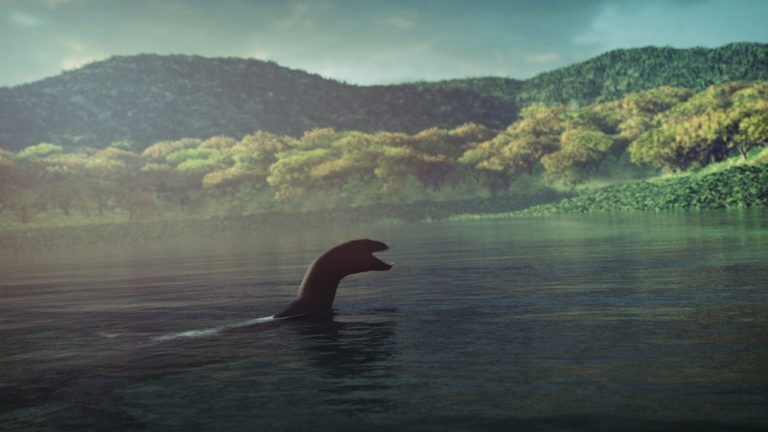
Cryptozoology is derided for pseudoscience and fantastic claims, but when you consider some of the legends that have turned out to be real animals, it lends credibility to other potentially real cryptid creatures. And while the actual beasts are often more believable than the embellished monsters of lore, occasionally they can be pretty bizarre – whether a remnant of the Cretaceous period, a curious hybrid, or an inter-dimensional entity, some of these clandestine faunae are truly plausible.
That’s why we’ve compiled a shortlist of animals once-considered cryptids, that have now been proven real, using their stories as hope to strengthen our faith that the cryptid monsters we know and love may someday prove their existence to us.
But haven’t we discovered nearly every species of animal on Earth, you might ask? Far from it. In 2016 alone, scientists discovered roughly 18,000 new animal species. That’s not to mention that 80 percent of the world’s oceans are entirely unmapped, unobserved and unexplored, according to the National Oceanic and Atmospheric Administration (NOAA). So, who knows how many more could be down there.
Read through the first list of creatures proven to be real, then read the second list and determine whether there is enough evidence for the yet-to-be-proven-cryptids to have a basis in reality. We’ve provided cryptid pictures to help you along the way.
Cryptid Monsters Proven Real
Cryptid monsters are known to terrorize and typically reported by a significant portion of a population, or at least a large enough group to confirm that it is indeed an anomalous creature. In earlier years, these animals were brutes fought by hunters and fishermen on outings and were exaggerated to prove their machismo upon returning home. But eventually, these tales became backed by hard evidence, and today we know them well.
-
The Giant Squid
19th-century Scandinavian whalers spoke of the Kraken; an enormous squid whose appendages were found in the bellies of whales and said to be as thick as a ship mast. Fishermen continued to report attacks by these tentacled monstrosities, to the disbelief of landlubbers back home. But eventually, they returned with specimens or found their carcasses washed ashore.
In 1853, a large squid with a horny beak and large throat washed aground in Denmark, baffling local scientists. Johan Japetus Steenstrup, a professor of zoology from the University of Copenhagen, identified the creature as a giant squid.
Today, the giant squid is a scientifically accepted animal, reaching lengths up to 40 feet long. Their enormity is attributed to something called deep-sea gigantism; a tendency for deep-sea invertebrates to be larger than their shallow-water relatives. But the giant squid isn’t even the biggest mollusk of its kind, that title is reserved for the colossal squid, which reaches up to 46 feet in length.
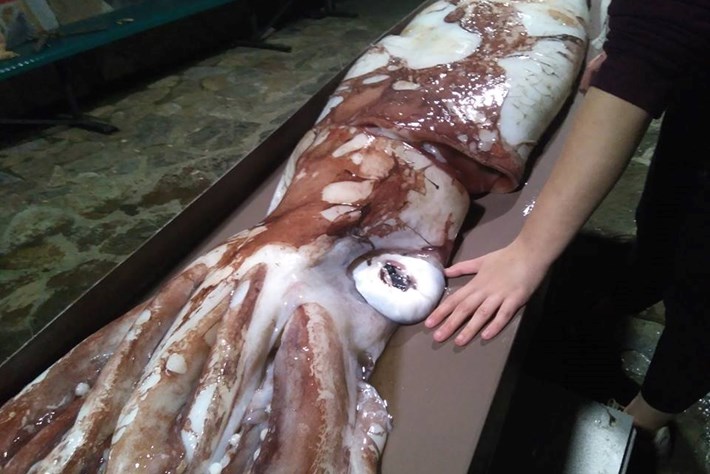
Image: Luis Laria, CEPESMA
-
The Platypus
The platypus is a rather bizarre-looking creature and if you attempted to explain it to someone before its discovery, they’d almost certainly believe you were mad. So, it’s an egg-laying mammal with the bill of a duck, the tail of a beaver, the webbed-feet of an otter, and the venom of a snake? Sure.
But now the platypus is a well-known creature, lending credence to the possibility of other cryptids that seem to be an amalgam of disparate species. When it was first presented to British zoologist George Shaw, he attempted to rip off its beak, believing it had been glued on. Eventually, he took scissors to the deceased animal, before he realized it was genuine. That particular specimen can be found to this day in a British museum.
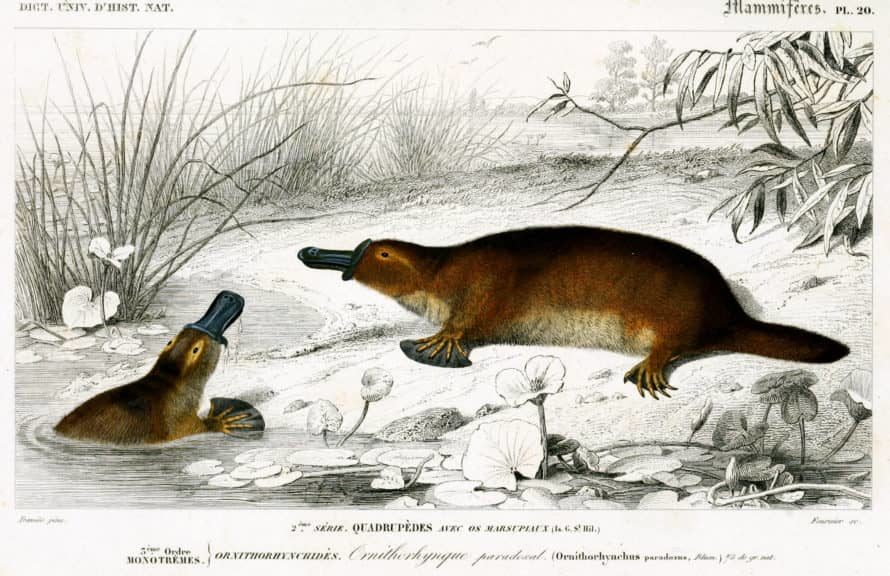
-
The Frilled Shark
Sea serpents have stoked the fears of sea-farers for centuries, tormenting sailors and swallowing ships whole. From Texas to Norway, reports of sea serpents sprang up in local and national publications during the 19th-century, depicted as gargantuan snakes devouring unwitting mariners while they innocently roamed the sea.
Today, the frilled shark could be considered the closest animal to these horrific serpent tales, appearing much like those descriptions written in antiquity, though comparatively smaller. The frilled shark was discovered in the late 1800s by German ichthyologist Ludwig H.P. Döderlein, and later described by Samuel Garman as, “such an animal as that described is very likely to unsettle disbelief in what is popularly called the ‘sea serpent.’”
So, it’s a shark, but a frightening one at that, with 25 clusters of 300 sharp, serrated teeth, the Chlamydoselachus africana is one of those relics from the days when dinosaurs ruled the Earth. It’s also one of those deep-sea dwellers, which is part of the reason they are so rarely seen.
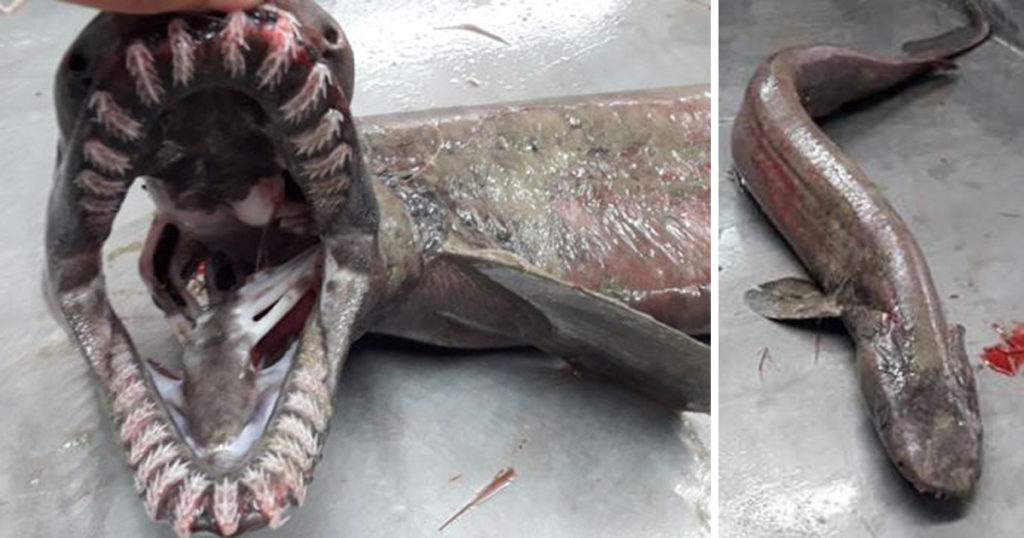
Images: IMPA/MINOUW Project



